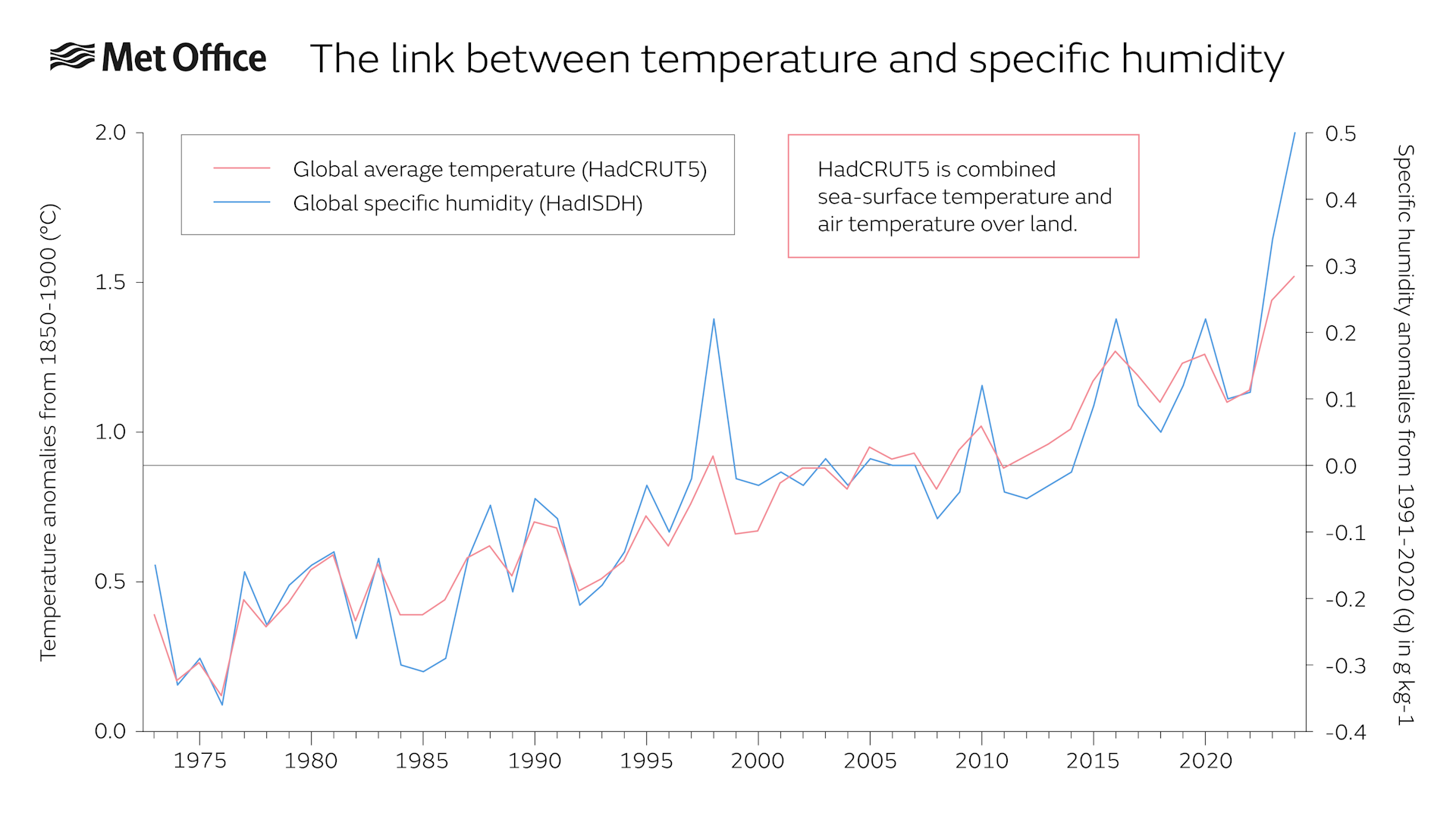Global humidity reached record levels in 2024, says latest climate report
Author: Grahame Madge
14:00 (UTC+1) on Thu 14 Aug 2025
The latest report on global climate change highlights the impact of higher global temperatures on the water cycle, with atmospheric water vapour levels reaching record levels during 2024.
As the atmosphere continues to warm, the amount of moisture a parcel of air can contain also rises. This moisture content is recorded as humidity, which when combined with rising temperature can pose a significant threat of heat stress to communities.
Near the surface, specific humidity – the amount of water vapour in a parcel of air - reached record levels over both land and ocean last year. Relative humidity – a measure of the saturation of a parcel of air – also reached higher levels than in 2023. Total column water vapour – the total amount of water within the atmosphere above the surface - reached record levels over both land and ocean with almost 90% of the atmosphere wetter than the 1991-2020 average.
Remarkably, the global average number of high humid heat days (those where the wet-bulb temperature - a measure of humidity - exceeded 90% of normal levels) over land reached a record of 35.6 days more than normal in 2024, surpassing the previous record set in 2023 by 9.5 days.
The State of Climate report 2024 is published by the Bulletin of the American Meteorological Society (BAMS), and is the 35th in the series.
Human health
Dr Kate Willett of the Met Office is one of the report’s editors and wrote the sections on humidity. She said: “Human health can be seriously affected by high heat and humidity. Such a dramatic increase in the occurrence of these humid-heat events is bringing more societies into challenging, potentially life-threatening, situations.”
“Our report found that it’s not just high temperatures that people are having to contend with, it’s also humidity; with the frequency of high humid-heat days at a record level, and intensity of those days at the second-highest level in the record, only fractionally cooler than 2023.”

When the air is warm and humid it is far more difficult to offload heat from the body because sweating, and panting in the case of animals, is less effective. This makes any physical activity, and even mental concentration, more challenging. Continued physical exertion when exposed to high humid-heat can lead to serious health issues.
The report covers a wide range of metrics which are used to monitor our climate. Almost 600 scientists from many disciplines and from 58 separate countries contributed to the report. The editorial team of the Global Climate chapter is led by the Met Office, and focuses on metrics from the land and atmosphere. Other chapters cover the oceans, tropics and polar regions.
Other key climate metrics for 2024
- The atmospheric concentration of the three anthropogenic greenhouse gases reached record values: carbon dioxide (422.8 parts per million); methane (1930 parts per billion); and nitrous oxide (337 parts per billion). Carbon dioxide had the record-equal highest year-on-year growth at 3.4ppm over 2023.
- Globally, 2024 was the warmest year on record exceeding 2023. It was the tenth consecutive year >1.0 °C above pre-industrial levels. The last ten years are the warmest ten years in the instrumental record.
- All 58 reference glaciers reported negative mass balance – losing more ice than they gained - only the second year this has occurred alongside 2023. 2024 was the 37th consecutive year of average negative mass balance.
- Colombia’s Conejeras glacier was declared extinct, and Venezuela declared that all of its glaciers have now officially disappeared.
- It was the wettest year for extreme precipitation as measured by maximum 1-day rainfall amounts. Record-breaking extremes mostly occurred within the tropical belt, and many occurred anomalously within extended droughts or were seasonally unusual.
Dr Robert Dunn, lead editor of the Global Climate chapter, said: “This latest report again highlights the ongoing and consistent changes within our climate in response to increasing concentrations of greenhouse gases. Not only did global average surface temperature yet again reach record values, but many metrics assessed within the BAMS State of the Climate report also reached record high or low values in 2024, in several cases breaking records set only in 2023. The coherent changes across our land surface, in our oceans, and in our atmosphere show how our climate is being forced into new states.”
Professor Stephen Belcher is the Met Office Chief Scientist. He said: “The changes to global climate highlighted in the BAMS State of the Climate Report indicates the need for deep, rapid, and sustained reductions in greenhouse gas emissions from burning fossil fuels in order to limit warming as much as possible, alongside scaled up adaptation action to protect societies and nature already exposed to impacts from record breaking extremes.”
Many of the metrics in the BAMS State of the Climate report are also shown on the Met Office Climate Dashboard.


